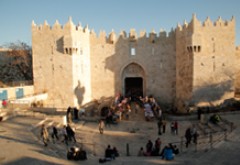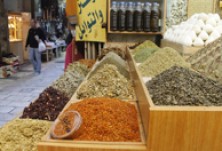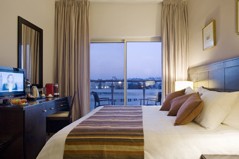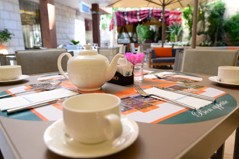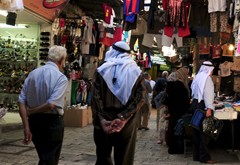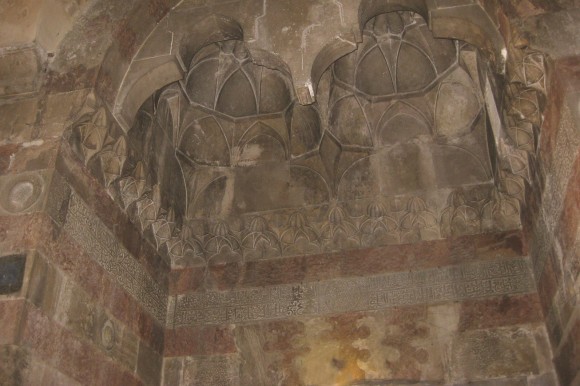To reach al-Dawadariyya, one should walk towards Bab al ‘Atm street, one of the north al-Aqsa Mosque gates, by entering Bab al-Sahira (Herod’s Gate) and walking down al-Qadisiyya street until its southern end, then turning east at the Mujahidin street. A few meters on, turn right to Bab al-‘Atm. It is not possible to enter the Dawadariyya because it is presently a school for children with special needs. Examining the details of its façade ornaments requires a flashlight.
Location, Name, and Founder
The Dawadariyya is located directly south of the Salamiyya School on Bab al-‘Atm Street, branching from l-Mujahidin Street and adjacent to al-Aqsa Mosque from the north. This seminary, known according to its founding documents as Dar al-Salihin (home of the pious), obtained its original name (Dawadariyya) from its founder, Amir ‘Alam al-Din Abu Musa al-Dawadar. Dawadar was one of the important positions during the Mamluk era, occupied by important princes. ‘Alam al-Ddin also occupied a number of important positions and missions during his active administrative, military and scientific life. He was known for his compassion towards Sufis and sponsorship of science and scientists. His home was believed to resemble a mosque.
Details of and Incentives for the Waqf
The inscription above the entrance provides important details about the reasons behind establishing the seminary and its financial resources. It indicates that the Khanqa was established in an effort to please Allah (God), and to provide shelter to 30 members of Arab and non-Arab members of the Sufi order, twenty of whom were bachelors and ten were married. Any Sufi arriving at the seminary would be hosted for a period of ten days. Among the conditions were teaching Hadith (Prophet Mohammad’s sayings and actions), the Holy Quran, and the Shafe’i school of jurisprudence. To guarantee that the khanqa would continue to play its role, and to provide its running expenses, the founder provided it with generous religious endowments (Awqaf), including the village of Bir Nabala, north of Jerusalem, the village of Hijlah near Jericho, and a number of properties interspersed around Jerusalem, Nablus and Bisan.
Architectural Characteristics of al-Khanqa
Al-Dawadariyya is characterized by its original design and beauty of its architectural details. Its only entrance, opening to the west, is a unique architectural marvel in the Jerusalem architecture. It does have similar examples in the architecture of Damascus, however. It was built from interlocking red and grey stones until the beginning of the vault covering the recessed entrance. Above the entrance opening is a stone lentil, followed directly by a relieving arch composed of connected stones. Above that is the string of inscribed text mentioned above. Three rows of beautifully formed stalactite stone elements are then seen. Ahead of the entrance cover, towards the street, are two triple arches with pointed openings, preceded by a pointed arch formed from connected colorful stones. The entrance leads directly to an open, rectangular courtyard, paved with large stone tiles. The courtyard is surrounded from the north and south by small sanctums where the Sufis used to live. On the south side is a large rectangular hall composed of three sectors, which was used for teaching the Quran and Hadith, and as a meeting place for Sufis residing in al-Khanqa.

